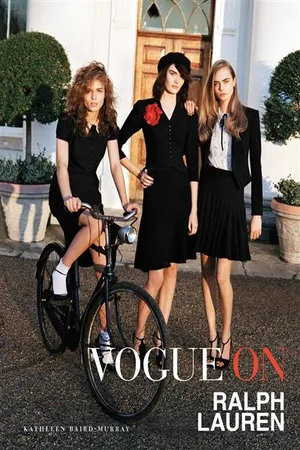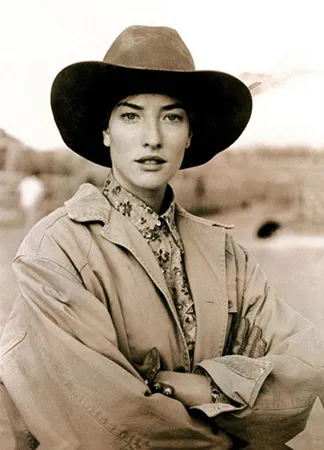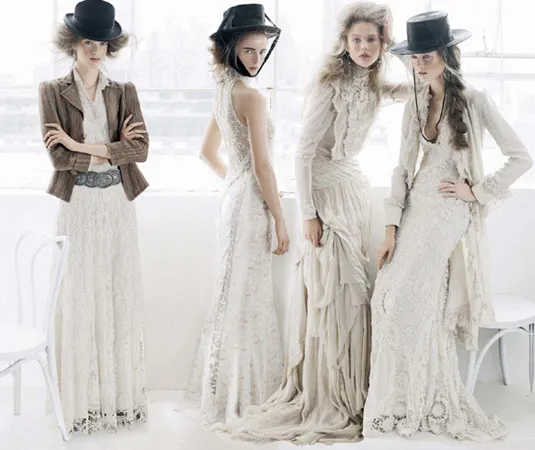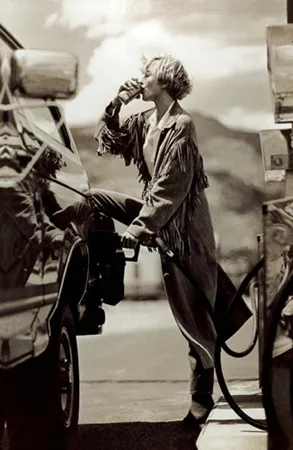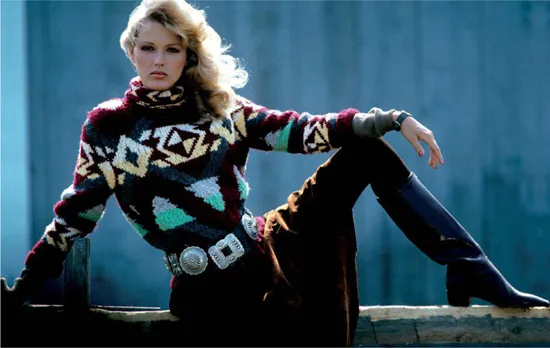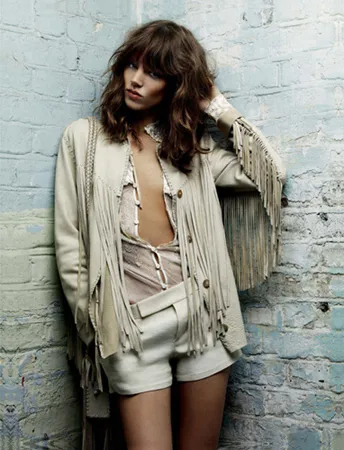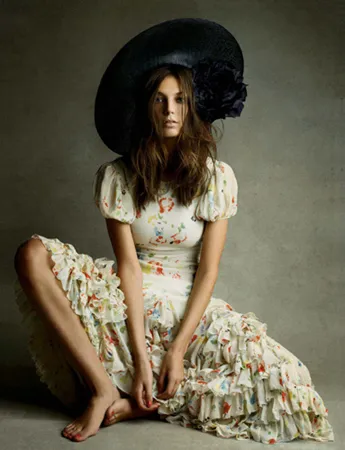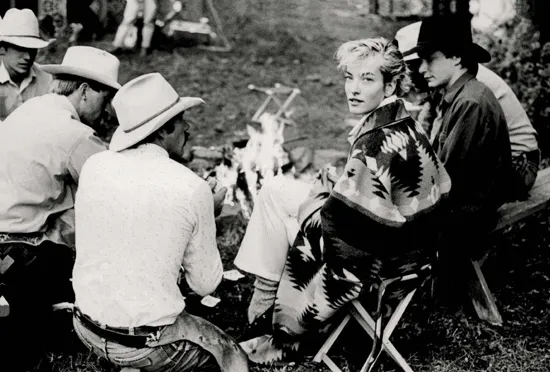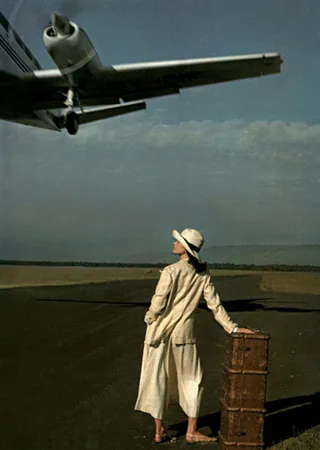![]()
A
“I’m not an artist working alone in his studio, designing the perfect armhole,” Lauren once said. “I was the guy looking at the magazines and movies, saying ‘Wow, that’s where I’d like to be.’ The way I see it, you’ve got to paint the environment. It’s not just the car, it’s where you’re going in that car. I’m trying to paint a wonderful world, a life that makes you feel good. Maybe I’m redefining a life we lost. That’s my movie. What’s yours?” If Lauren’s clothes were movies, Western wear was about to be his great American blockbuster, capturing the frontier spirit, the cowboys sitting around the campfire, the traditions of the Native Americans, all of which were held dear by an entire nation. It would be a happily-ever-after leitmotif he would return to in the same way you could rewatch a classic cowboy movie, only reworked around certain staples, like the concho belt (a leather belt embellished with burnished metal emblems) and the Navajo jacket. As it evolved it would at times be bolder, as with his fringed pants and jackets; or prettier, as with the lace petticoats, but he would always stay on the right side of classic, rather than stray into the realms of caricature.
In 1978, while New York was getting on down to the Bee Gees’ “Saturday Night Fever,” the models who stepped out on Lauren’s fall/winter catwalk show were accompanied by Gene Autry’s gently lilting Western classic, “Back in the Saddle Again.” Hidden in the lyrics is the line, “I go my way”—apt for Lauren, whose brave move to go west, taking a left turn away from his popular mannish styles was to prove a surefire hit, appealing to urban cowboys everywhere. “Western is Lauren’s big statement for fall ’78, but it’s very much his own way with the West: fringed buckskin, chamois, or leather jackets; flounced prairie skirts with tweed jackets; shearling vests,” wrote Kathleen Madden in American Vogue. “Un-hokey pieces that can slip into – not rupture – a woman’s wardrobe [closet].” The finale of the show featured a disco. Beverly Johnson appeared in a long red mink coat with a concho belt and high gold cowboy boots to a backdrop of flashing lights.
Model Tatjana Patitz shows off a utilitarian side to Western wear, boyish yet feminine when styled with a floral cotton shirt. The cotton canvas coat is typical of the workwear aesthetic of Lauren’s Roughwear line. Photographed by Arthur Elgort for American Vogue, 1989.
A
“THE FRONTIER ALWAYS DREW DREAMERS …”
VOGUE
Exquisitely ethereal, Ralph Lauren’s lace and crochet gowns portray a fantasy of Americana meets Edwardiana, captured by Mario Testino for American Vogue, 2011, which called them “the new romantics.”
The fringed detail of Western wear, brought by Ralph Lauren to the urban lifestyle, made city cowboys of us all. Tatjana Patitz, in a soft suede coat, stops for a refuel, photographed by Arthur Elgort for American Vogue, 1989.
The appeal was instantaneous. Here was a look that was so much a part of the American psyche it was a wonder no one had pulled it together before. “It has a pioneer look,” Lauren said at the time. “It has an earthiness. It has realness. It’s not costumey. That’s what I relate to.” He’d been a fan ever since he was a boy, and would regularly turn up at black-tie events wearing a Western-style tie with a formal dinner jacket. “The Western thing for the woman, I think is very much the same as it is for the man: wearing things that have a classic integrity to them that are not fashion per se, but that are individual. They are romantic in that they represent a world that we’ve all grown up with and love, whether it be through the movies or our dreams. You know, Western clothes could be dumb. They could be corny. They could be glossy. I sense a romanticism, and I express this in texture, in the quality, the spirit I believe in. My Western clothes look like me, they don’t look like Roy Rogers.”
The Old West was now the stuff that dreams were made of, with urban cowboys popping up everywhere. “New York has become something of a cowboy town,” wrote The Times. “Men whose idea of a canyon is the space between two rows of skyscrapers take the air in full regalia – 10-gallon hat, yoked shirt, embroidered denim jacket, hand-tooled belt, jeans and boots. And the women beside them wreathe their throats in bandannas, wear ankle-length skirts fit for a hoedown and – faced with inclement weather – don hats and ponchos worthy of the crew of a cattle drive.”
Lauren’s love of the West would endure. In 1980, he took Ricky and their children to New Mexico for a vacation which would provide the inspiration for his Santa Fe collection the following year. While Calvin Klein had also visited New Mexico that year and drawn on it for his collection, Lauren’s designs were a world away from Klein’s muted palette. Chamois skirts, turquoise hoop earrings, Navajo Fair-Isle sweaters with strong patterns and bright colors, mixed in ways not seen by the world’s fashion press before, looked fresh and exciting, especially when styled over his white cotton blouses, long prairie skirts, and full white petticoats.
Overnight, Ralph Lauren made the concho belt a collector’s item. “It’s a classic – like a good watch you keep forever.” Above, it ties together a Native-American-patterned wool turtleneck and suede dirndl skirt. Photographed for American Vogue, 1981, by Marco Glaviano.
Over the years Lauren’s signature fringing has evolved, but its roots remain firmly entrenched in the romance of the Old West. Freja Beha Erichsen demonstrates the modernity of the look, photographed by Patrick Demarchelier for British Vogue, 2011.
Daria Werbowy in a floral silk georgette tiered dress puts a spin on the classic Edwardiana fantasy. Photographed by Patrick Demarchelier, for British Vogue, 2008.
“I’ve always had a sense of the many things in this country that were interesting, and Americana was very appealing to me,” he explained. “With the Indian blankets, I happen to like the colors, the fade, the warm materials.” The blankets would eventually lead to sweaters and would also be incorporated in his home collections.
Overnight, concho belts—made from the silver pieces developed by the Navajos and then adapted by the Pueblo tribe of New Mexico—became collector’s items. Lauren teamed them with bare midriffs and long rickrack skirts for his resort collection. “The concho [belt] is a classic – like a good watch you keep forever – a wonderful investment and I believe in that kind of product. It looks great – whether you wear it with corduroys or thin summer cottons. It’s the antique of the future.”
The look was much copied by others. Lauren deliberately created his following collections as softer, less literal interpretations; he cites his fall 1982 show as being one of his great collections, with its gentle, Folk-Art feel and pioneer influence. He also focused on the more workwear aspects of the West, as reflected in the 1989 American Vogue shoot by photographer Arthur Elgort. To critics who accused him of plundering tradition, he had this answer: “I was inspired by the West, by things no longer here that I wanted to see again. I couldn’t buy a great Western shirt anywhere. Everything was polyester.” Meanwhile, his nod to Americana was more than appreciated by the associated crafts and design industries it breathed a new energy into. In 1988 the American Folk Art Museum honored Lauren with an award for Pioneering Excellence in American style. That same year, Deborah Turbeville photographed Faye Dunaway wearing Ralph Lauren in Santa Fe. The caption described the scene accordingly: “A woman alone on a big ranch, terribly isolated on a perfectly beautiful day. At one with nature but subtly menaced by the stillness.” The Western look captured the imaginations of all.
Lauren has an enduring love for Native American geometric patterns, interpreted here in a long Navaho-print wool coat, modeled by Tatjana Patitz and photographed for American Vogue by Arthur Elgort in 1989.
A
“I WAS INSPIRED BY THE SPIRIT OF THE RUGGED WEST, THE ROMANCE OF THE PRAIRIE, AND HOW A MODERN, STYLISH WOMAN WOULD WEAR IT.”
RALPH LAUREN
Life on the Prairie, and the beauty of Navajo Fair-Isle sweaters mixed with patterned coats and dirndl skirts, captured the essence of Americana and showcased it to the world. Photographed by Bruce Weber, 1982, for British Vogue.
Ralph Lauren, with campaign girl Clotilde wearing a patchwork jacket. One of the first designers to recognize the importance of telling a story through his advertising, he worked with a “family” of models to create a narrative that allowed him to sell his clothes as total looks. Photograph by Eric Boman for Vogue Paris, 1982.
It was an association that was mutually beneficial, with Weber likening his relationship with Lauren in the early days as being like that of an adopted son receiving an expensive college education, as he was dispatched around the world to gather ideas. “Ralph would send me to Paris to take pictures and explore the French underground and nightlife,” he said, years later, in Vogue Paris. “He also sent me to London to photograph these aristocrats he knew through books and movies, people who attended elegant men’s clubs, went to dinner dances at the Connaught and Claridge’s or lived discreetly in Mayfair mansions containing more dogs than could be counted on both hands.”
With Weber, but sometimes with other A-lister photographers such as Sheila Metzner, Lauren rolled out a series of detailed campaigns that would sometimes run to twenty pages. All were propped down to the tiniest characteristic, from exactly how worn the carpet should be to the number of walking sticks positioned in the hallway. His shoots were as alive as movie sets with an all-important narrative and a cast of men, women, children, and animals. Most of all, they allowed Lauren to record his clothes as total looks, to set them in an atmosphere that conveyed his particular vision; in so doing, he created the concept of clothes as lifestyle.
The perfect Ralph Lauren Safari jacket: Christy Turlington filming in Guatemala in 2009 for her documentary, No Woman, No Cry about global maternal health. Photographed by Alex Majoli for American Vogue, 2009.
Reviving the era of glamorous travel: Andie MacDowell impeccably dressed in a raw silk jacket and linen culottes, photograp...
